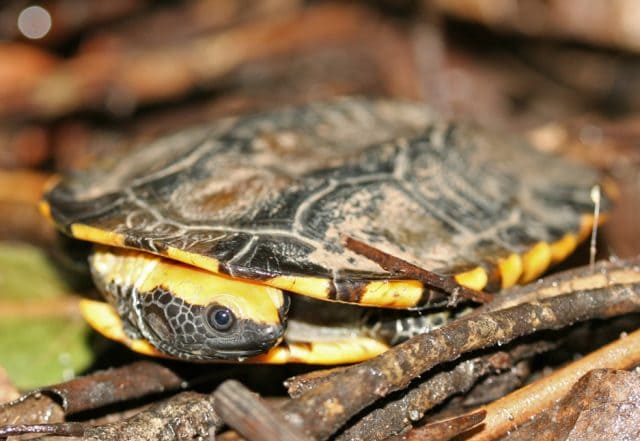Type the name of the breed you're looking for below
[wpdreams_ajaxsearchlite] Don't see the breed your're looking for? Click here and let us know!
Twist-Neck Turtle
| Place of Origin and Range | The twist-necked turtle inhabits a large area throughout northern and central South America, from the southern Orinoco drainage in Venezuela to the Amazon basin in Brazil. |
| Description | When threatened, this turtle withdraws by twisting its head into its shell. P. platycephala is the only species of the genus Platemys and occurs in northern and central South America. Platemys platycephala means “flat turtle, flat-head” and accurately describes the structure of the head and shell. |
| Morph Patterns Available | No |
| Adult Size | Can grow up to 7in(18 cm) |
| Accommodation | It is found in a wide variety of habitats, including floodplain swamps, marshes, seasonal wetlands, and permanent ponds. A filtered semi-aquatic cage with water temperature at 70-80'F(21-26'C), and a sloping ramp(driftwood, textured plastic or some other non-abrasive surface) leading from the bottom to an illuminated and warmed basking spot. Approx 80'F(27'C). 2 x 4 feet for an adult. |
| Lifespan | Can live |
| Feeding / Diet | Naturally, Twist-necked Turtles prefer amphibian eggs and consume various insects, mollusks (snails and slugs), amphibians, and some plant life through terrestrial and aquatic foraging. |
| Breeding | Mating typically occurs during the rainy season of the Amazon rainforest (late March to early December). Males follow females, mount from behind, then proceed to rub their chin barbels (fleshy filament) against the top of females’ heads. Some authors also report violent biting and water expulsion from the males' nostrils during copulation. Coupling has been observed on land and in water, and usually occurs late in the afternoon or at night. Oviposition occurs during the dry season (late December to early March) when the female deposits a large, oval egg (around 5 cm long and 2.5 cm wide). Many herpetologists report females depositing another egg a few weeks later while some recreational collectors report multiple eggs at a time. Shallow indentations are made to deposit eggs, and then they are lightly covered by sand and/or leaf litter. |
| Other Considerations | Watch for theses health concerns carefully with your turtle. Vitamin A Deficiency: Vitamin A is an important nutrient for your turtle’s health. It is found in his diet in the form of leafy green, orange or yellow vegetables, liver, and fish. If your turtle is not getting enough Vitamin A, he can suffer serious health problems. Always check to make sure that your turtle does not have swollen eyelids, as this is the main sign of a Vitamin A deficiency. Also, check for weight loss, nasal discharge and infected skin. Any of these symptoms could point to a deficiency. If you think your turtle may not be getting enough Vitamin A, you should take him to the veterinarian to get a firm diagnosis. Shell Problems: Your turtle’s shell is very important to his overall health. There are many potential problems that could occur, so you should be on the lookout at all times. Respiratory Disease: Respiratory infections have symptoms similar to vitamin A deficiency, including swollen eyelids and runny nose, so you should take your turtle to the veterinarian to get a proper diagnosis if you suspect either. More serious infections will be characterized by breathing through the mouth, mucus in the mouth, and wheezing. Always make sure your turtle’s environment has the proper amount of humidity, as this will help prevent respiratory problems. |



